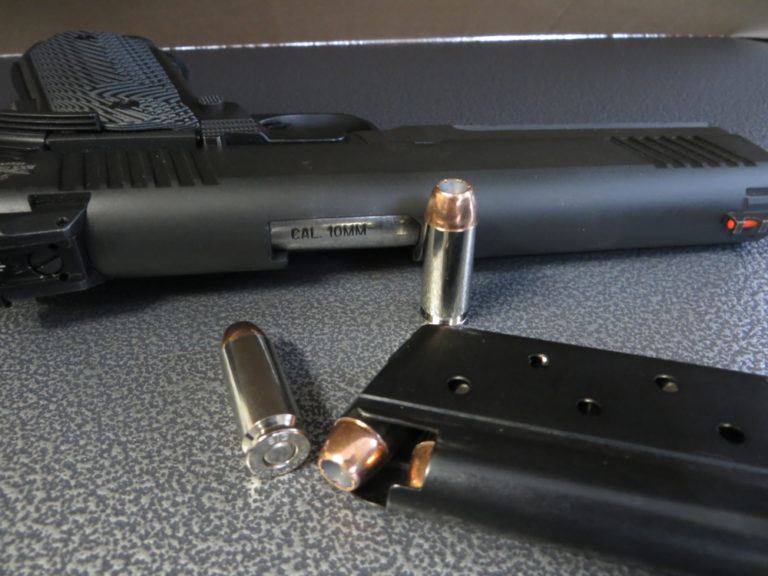
When it comes to the 10mm vs .45 ACP, application decides the winner.
Points to consider when deciding between the 10mm vs .45 ACP:
- Cartridge application
- Recoil sensitivity
- Potential need for fast follow-up shots
- Handgun size (.45 has more compact options)
- Average engagement range
- Price per round (one is a bit more spendy than the other)
The quest for the perfect handgun is ongoing and always evolving. In recent years, at least among those with a yen for powerful semi-automatic pistols, a gauntlet of sorts has been laid down: 10mm vs .45 ACP. Funny thing, go back 40 years or so and this debate wasn’t really … well … a debate.
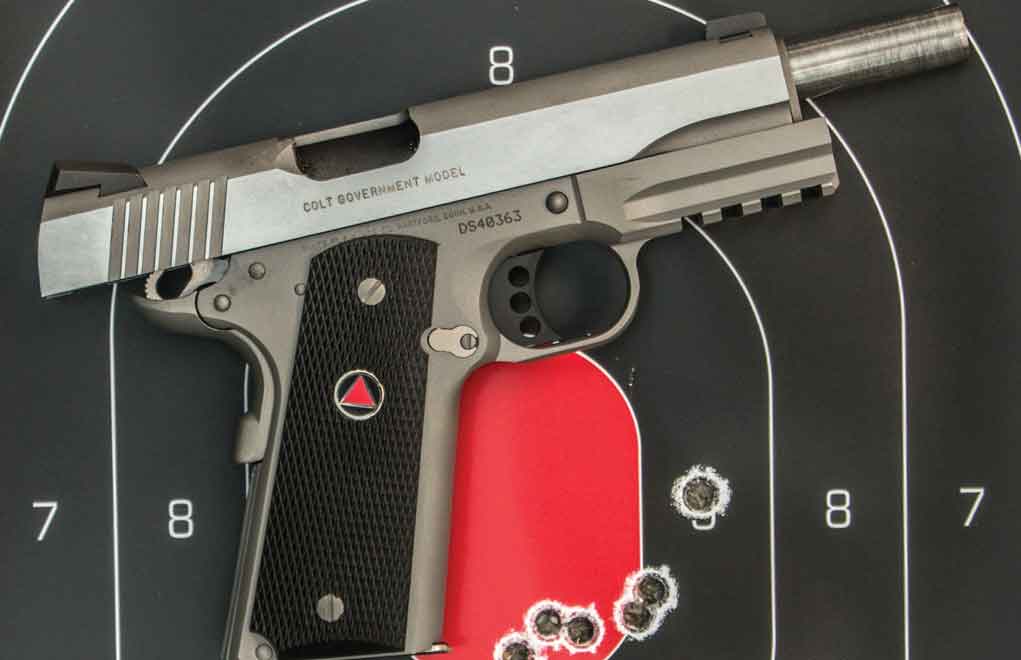
The new kid on the block, an oddity at that, the 10mm never really got out of the shadow of the grand old .45 ACP. Closing in upon its centennial birthday, John M. Browning’s masterpiece stood alone when it came to big-bore semi-auto cartridges. The 10mm, with all its potential, looked ready to fade away from early glory, following the likes of the .44 Auto Mag and other powerhouse semi-auto cartridges.
Then a funny thing happened. In the early years of the 21st Century the 10mm rose from its ashes. And while Col. Jeff Cooper’s darling has never become quite the belle the .45 Auto has remained, it certainly has turned heads enough to become a consideration among those who yearn for big and bad.
So, in the grand battle of 10mm vs .45 ACP, which is it to be? The answer — like everything in the gun world — isn’t as clear-cut as simply jumping on one team or the other. Both are excellent, with plenty of crossover application. But at their quick, each excels a little more than the other at certain tasks.
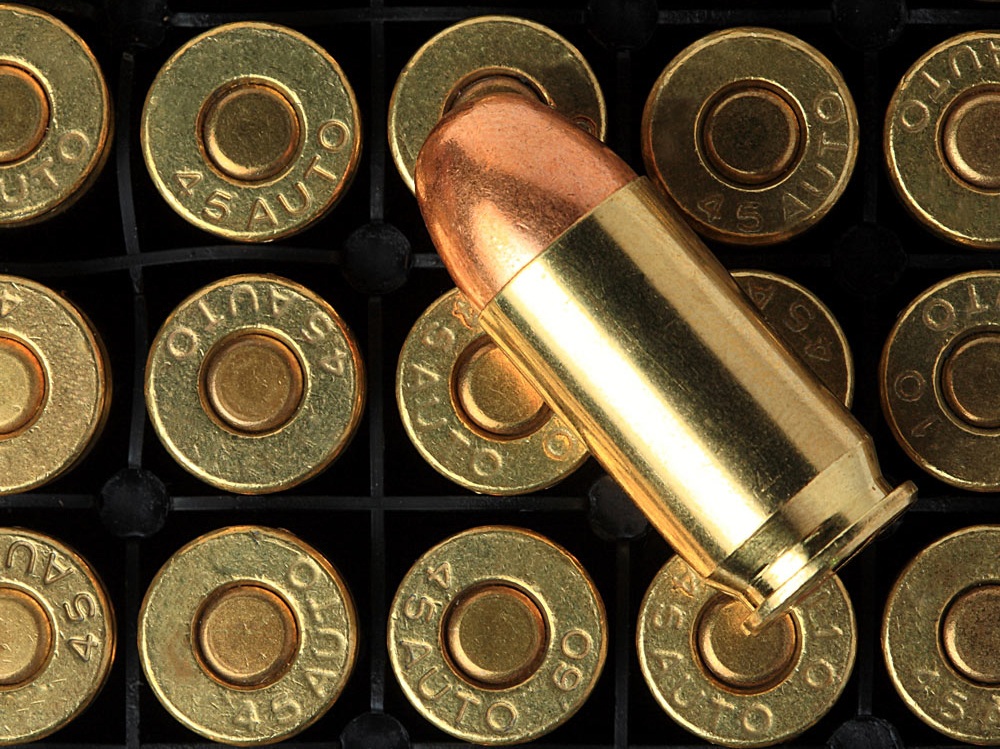
If your answer isn’t “Give me one of each!” then you need a long hard chew on what you plan to do with your new 10mm or .45 ACP before getting one. Doing so, you're more likely to find the brute that best serves your needs.
10mm vs. .45 ACP Comparison
10mm Auto
Bullet Diameter: .400
Max COL: 1.26
Case Length: .99
Common Bullet Weights: 155gr, 180gr, 200gr
Velocity Range: 1,050-1,410 fps
Year Developed: 1983
.45 ACP
Bullet Diameter: .452
Max COL: 1.17
Case Length: .898
Common Bullet Weights: 185gr, 230gr
Velocity Range: 770-900 fps
Year Developed: 1905
- Energy: The 10mm delivers more energy on target compared to the .45 ACP. An example, a 200-grain 10mm load delivers around 500 foot-pounds of energy, whereas 230-grain .45 ACP delivers around 375 foot-pounds. Winner: 10mm
- Velocity and Trajectory: 10mm has a much faster velocity, thus have a flatter trajectory than the .45 ACP. However, at most handgun ranges this trajectory is negligible. Winner: 10mm
- Recoil: Generally, the 10mm loads produces significantly more recoil than the .45 ACP when fired from pistols of similar weight. Winner: .45 ACP
- Cost and Availability: The cost of 10mm ammunition is similar to .45 ACP, however, specialized 10mm loads tend to demand a premium price. Winner: Draw
- Self-Defense: Both the 10mm and .45 ACP are proven self-defense rounds, however, given the 10mm’s recoil it can prove more difficult to place accurate follow-up shots. Winner: Draw
- Animal Defense: Given its high-velocity and ability to deliver a massive amount of energy on target, the 10mm is among the most popular backcountry pistol rounds presently. Winner: 10mm
.45: Close-Quarters Star

Purpose designed as a man stopper, the .45 ACP has shined in the role for more than century. Most know the story, at the turn of the 20th Century the .38 Long Colt had a poor showing against determined opponents in the Moro Rebellion. In turn, the U.S. Military went searching for a more substantial replacement. Looking forward by looking back, it was decided something along the lines of a .45 Colt would fit the bill.
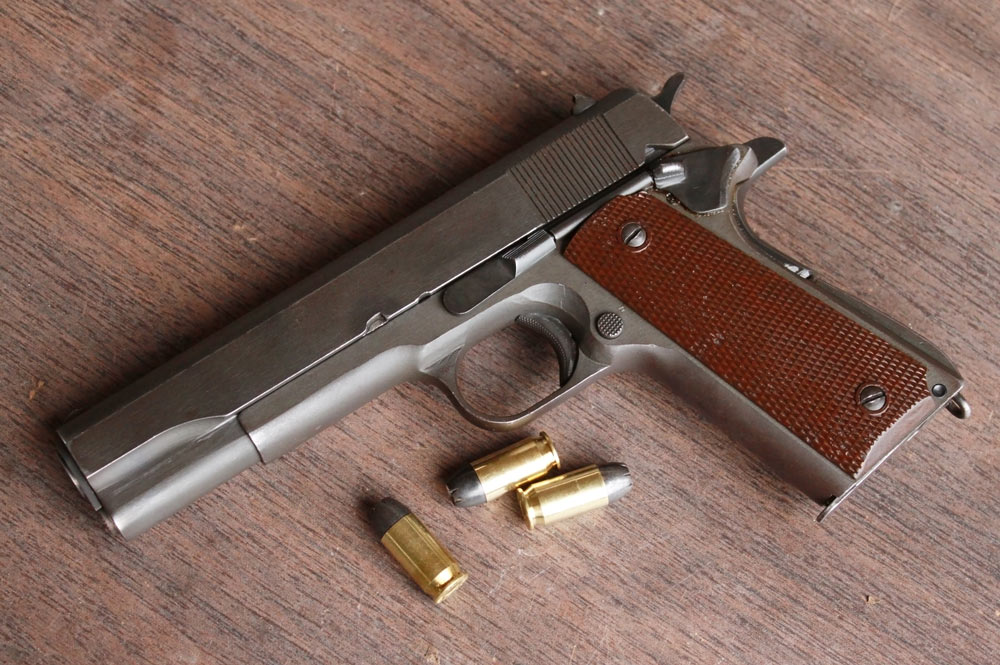
As luck would have it, John Browning was working on the perfect cartridge at the time — the .45 ACP used in the Colt 1905. Eventually matched with his legendary 1911 pistol, the cartridge and handgun went on the make history. Both served the U.S. Military with distinction for the better part of the 20th Century, including both World Wars and numerous smaller conflicts. Standard bearer statue achieved, it continues today as a favorite of armed citizen and a law enforcement alike, offering manageable power with proven results.
Aside from its ability to dissuade an attacker with sizable chunks of copper-jacketed lead, the large-bore round won favor because of a less recognized asset — it isn’t a bear to shoot. Certainly out of most pistols it generates more recoil than say the 9mm, but not a universe more. Give time, practice and willingness to learn, only the truly recoil sensitive are nixed from the .45. The vast majority of other shooters can master it.
Get An Edge On The 10MM:
- A Perfect 10: The Best 10mm Pistol
- Best 10mm Ammo For Self-Defense And Hunting (Updated 2024)
- Glock 10mm: The Caliber's Stalwart Option
- The Best 10mm Deer Hunting Ammo Options for Hunters
- Factors to Consider: Is 10mm Better Than .45 ACP?
- Maximizing Performance: 10mm Muzzle Energy Explained
The effort to become competent with the cartridge out of the many pistols chambered for it is worth it. In the skilled hands, the .45 ACP absolutely sings. Watch a practical pistol or steel challenge match and consider, the majority of the pistols being accurately redlined are chambered for the short, fat cartridge.
How does the .45 ACP achieve the seemingly contrary ends of power and manageability? Simple, it’s a low-pressure cartridge that shoots heavy bullets slowly. Take, for instance, a relatively average .45 ACP self-defense round, such as a Remington’s 230-grain Golden Saber. It leaves the muzzle at 875 fps, yet at this velocity it’s working with 391 ft-lbs of energy. Not blistering hot by anyone’s standards, but within typical self-defense ranges it has more than enough punch to get the job done. The Achilles’ heel of the cartridge, the further you have to shoot, the more difficult it is to achieve accuracy — the .45 drops, a lot, fairly quickly.
.45 ACP Ballistic Data
| Load | Bullet (grains/type) | Muzzle Velocity (fps) | Muzzle Energy (foot-pounds) |
| Federal Premium Gold Medal Match | 185gr semi-wadcutter FMJ Match | 770 | 244 |
| PMC Bronze | 185gr JHP | 900 | 333 |
| Fiocchi Defense Dynamics | 200gr JHP | 890 | 352 |
| Blazer Brass | 230gr FMJ | 830 | 352 |
| Speer Gold Dot | 230gr JHP | 890 | 404 |
As a self-defense option, particularly with today’s bullets, the .45 is Mojave rattler potent. While research is required to ensure satisfactory penetration from a defensive round, most bullets they're loaded with have mind-blowing expansion potential. At the extreme end, such as Winchester’s Ranger T-Series, the projectiles are fully capable of mushrooming to 1 inch in diameter. That equates to undeniably devastating wound channel.
Furthermore, the .45 ACP's common use also gives it the advantage of ample handguns and ammo options. The iconic 1911 still soldiers on, not only made by Colt, but a slew of other manufacturers — Kimber, Springfield, Remington, SIG Sauer and many more. Additionally, the .45 is also available in a number of other makes and models, such as the Springfield XD, Smith & Wesson M&P, Glock (21, 30, 36, 41) and nearly everything else not considered a pocket pistol. There’s even a healthy selection of compact pistols in the caliber, given the .45’s popularity for concealed carry. Rounds for those guns? If a store sells handgun ammunition it is a safe bet they’ll have .45 — at the bare minimum ball.
10mm: Multitalented Masterpiece
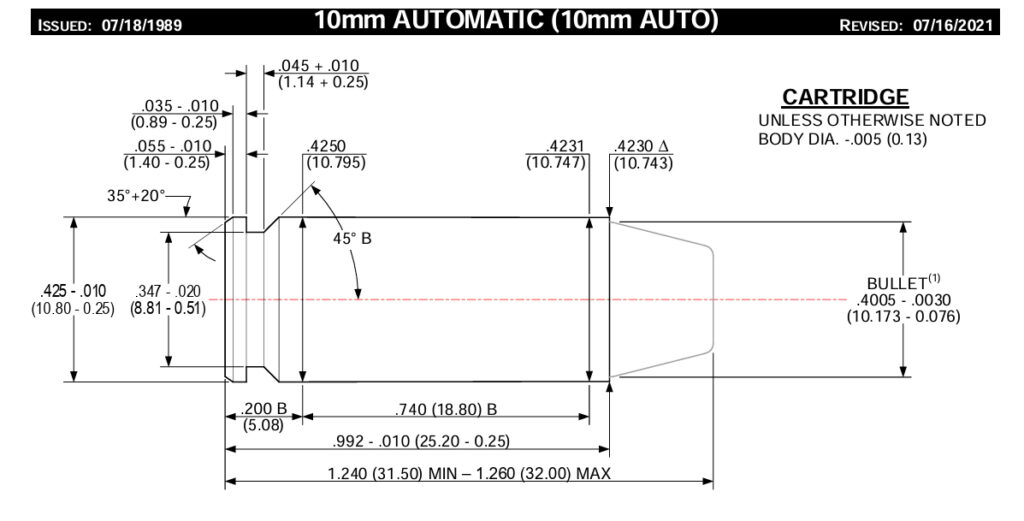
10mm Auto Specs:
Famed firearms instructor and all-around firearms guru Col. Jeff Cooper set out to do the impossible in the early 1980s — improve on the .45 ACP. A fan of the cartridge, he aimed to design an option that had superior ballistics and improved barrier penetration performance. Inspired by a wildcat, the .40 G&A, Cooper believed he had found a model to dethrone the king.
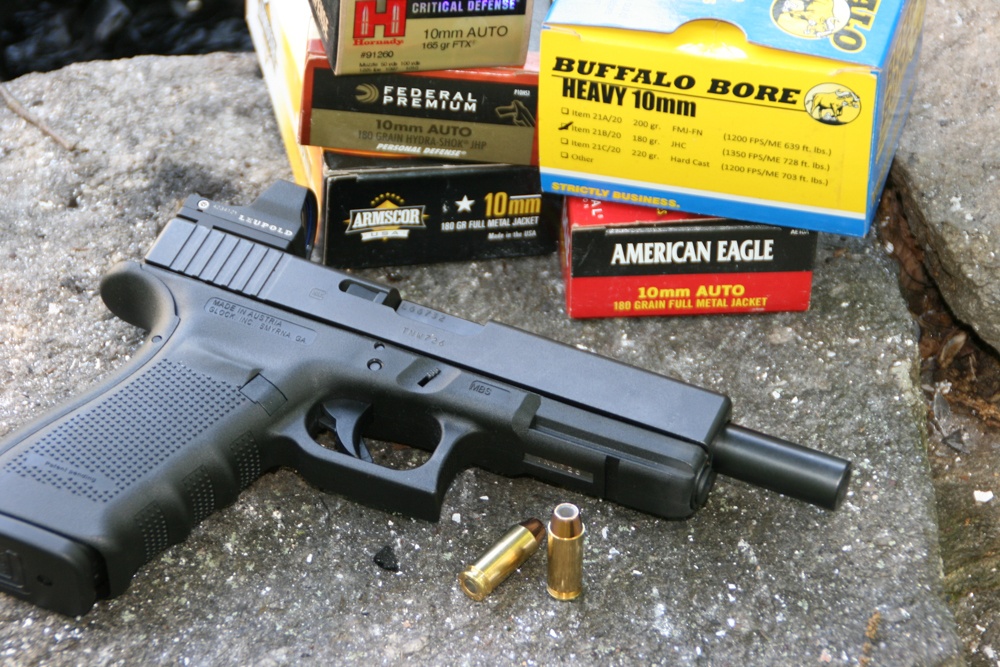
In concept, his “.40 Super” would pitch a 200-grain bullet at velocities in excess of 1,000 fps, more than enough to dust the .45 on all counts. Roughly, it would achieve 20-percent more velocity at the muzzle than the .45 and flirt with doubling its energy. Hard hitter fails to capture Cooper's ultimate goal. The idea eventually transformed into the 10mm and became a reality when he teamed up with gunmaker Dornaus & Dixon and Swedish ammo manufacturer Norma. As good as it looked on paper, in execution the “Big Ten” stumbled out of the gates.
The first gun chambered for the round — the Bren Ten — became notorious for its production issues and was priced like it was cast from gold. Then the 10mm round itself had its issue. By all accounts, it lived up to Cooper’s billing. The original 200-grain loads screamed from the muzzle at 1,200 fps, with a bone-crushing 759 ft-lbs of energy. In FBI testing, a 170-grain JHP from Norma ended up with the best “Wound Value” score. But it proved a handful.
Hot whiplash to shoot compared to semi-auto pistol at the time, 10mm shot-to-shot split times were painfully long. Not exactly ideal in the FBI's eyes, who adopted it for a short time in the 1980s and 90s. And the recoil was none too easy on the guns either, with a tendency to break them down before their time. The final nail in the coffin — at least in professional use — was a mid-velocity round that achieved the same terminal performance, while creating a highly shootable 10mm. The thing was, less powder meant excess case, a problem solved with the advent of the .40 S&W.
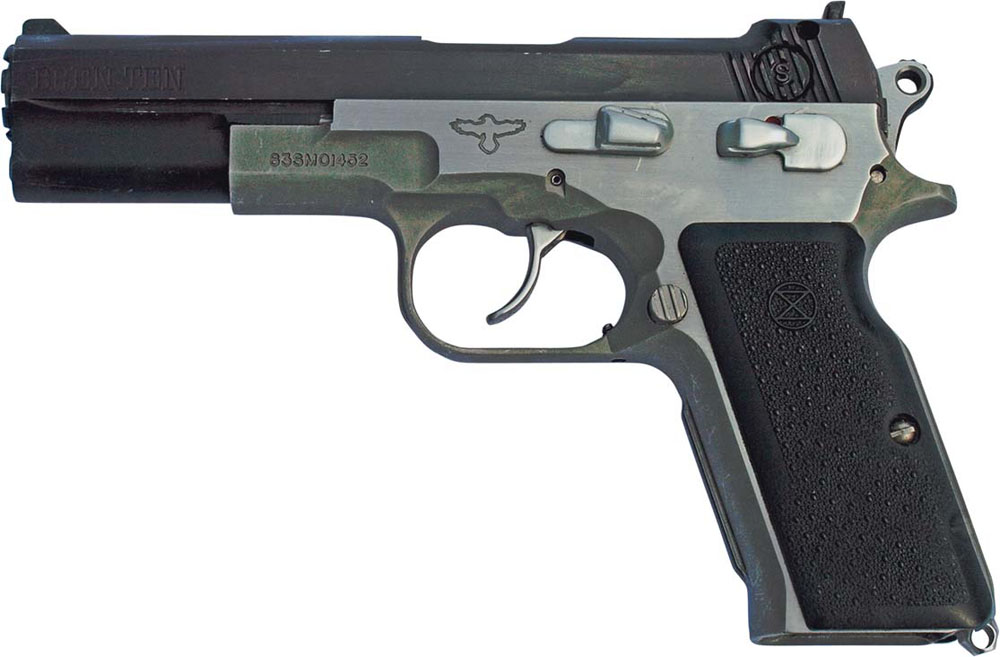
Colt with its Delta Elite and Glock with its G20 and 29 — along with a handful of diehard ammo makers — kept the 10mm from slipping into obscurity in the dry years after the FBI abandoned the caliber in the mid-1990s. Then, almost miraculously, interest in the 10mm peaked again after the turn of the century and in recent years has flirted with fever pitch. Difficult to say why shooters have re-kindled love for the nearly forgotten handful (most likely versatility), but in the past few years the market has responded.
Though not as widespread as the .45, nearly all the major gunmakers and a few boutique outfits offer the 10mm. Of the more notable are the Ruger SR1911, SIG Sauer P220, Remington R1 Hunter, Dan Wesson Bruin and Springfield Armory 1911 TRP RMR. Colt even dusted off its Delta Elite and Glock added the G40.
An interesting twist, while the 10mm is still popular as a self-defense option, it has punched a toehold in the hunting world. Reaching further with a substantial payload, the cartridge has been found chasing whitetails up north and hogs down south. Some even used as bear insurance out west.
10mm Auto Ballistic Data
| Load | Bullet (grains/type) | Muzzle Velocity (fps) | Muzzle Energy (foot-pounds) |
| Hornady Custom | 155gr JHP | 1,410 | 684 |
| PMC Bronze | 170gr JHP | 1,200 | 543 |
| Sellier & Bellot | 180gr FMJ | 1,165 | 542 |
| Blazer | 200gr FMJ | 1,050 | 490 |
| Speer Gold Dot | 200gr JHP | 1,100 | 537 |
| Buffalo Bore Outdoorsman | 220gr Hard Case Flat Nose | 1,200 | 703 |
Given varied applications, ammunition selection has blossomed along with its popularity. Since it fills certain niches, not every round is suitable for every application. A sledgehammer hunting round, such as Buffalo Bore’s 220-grain Heavy Outdoorsman, will make a hole in an attacker, no doubt. But if pass through is a concern, it might not be a wise choice for self-defense.
10mm vs .45 ACP Terminal Performance
When it comes to affect on target, the short answer is that 10mm is the winner. Its greater velocity simply translates to more energy transfer and more damage. But that's not the entire story.
Velocity and energy aren't the only things that impact terminal performance, as the diameter of the projectile plays a factor in what the wound cavity will look like as well.
Obviously .45 ACP has the edge there, but how much does it really matter? When looking at Lucky Gunner's ballistic gel tests of hollow point ammunition, the most expanding load of 10mm only achieved an average diameter of .81 inches, and it took a lightweight 155-grain load to achieve that. Meanwhile, the most expanding .45 ACP achieved an average diameter of .99 inches. That's over twice that of the original projectile's diameter and it was with a standard-weight 230-grain load. That means the .45 is making a hole that's almost .2 inches bigger than the 10mm, and depending on the ammo the difference can be even more extreme.
Does that mean that .45 ACP actually has better terminal performance? No, because expansion isn't the whole story either. The reality is that when it comes to effect on target, the wound cavity created is the best metric to look at, and 10mm's velocity still beats out .45's larger diameter in that respect. A good, modern expanding .45 ACP bullet will create a wound cavity almost as devastating as a 10mm, but at the end of the day the wound cavity made by a defensive 10mm round of the same quality will simply be a bit bigger.
10mm Vs. .45 ACP Ballistics
As far as reaching out and touching things goes, 10mm Auto wins again due to its higher velocity. While neither of these heavy handgun rounds were designed for long-range precision, their drop is relevant to both self-defense and hunting, so let's see how a .45 ACP and 10mm Auto Speer Gold Dot load compare to each other.
If my math is right, at 25 yards the .45 ACP will have only dropped .3 inches more than the 10mm, but at 50 yards the .45 will hit 1.5 inches lower than the 10mm. For typical self-defense distances, .3 inches doesn't matter too much, but if you're looking for a handgun hunting cartridge that can reach out a bit farther the 10mm is the clear winner. Plus, you never know when you might have to make an Eli Dickens-tier shot, and the 10mm's flatter trajectory will help with that too.
Who Wins Out In 10mm vs .45 ACP?
If you're in the market and weighing the 10mm vs .45 ACP, the question shouldn’t be “Which one should I buy?” That will get you nowhere. To get the right cartridge and the gun to launch it you should ask yourself, “What do I plan to use it for?” Arguably anticlimactic, fully admitted, but most sober decisions play out that way.
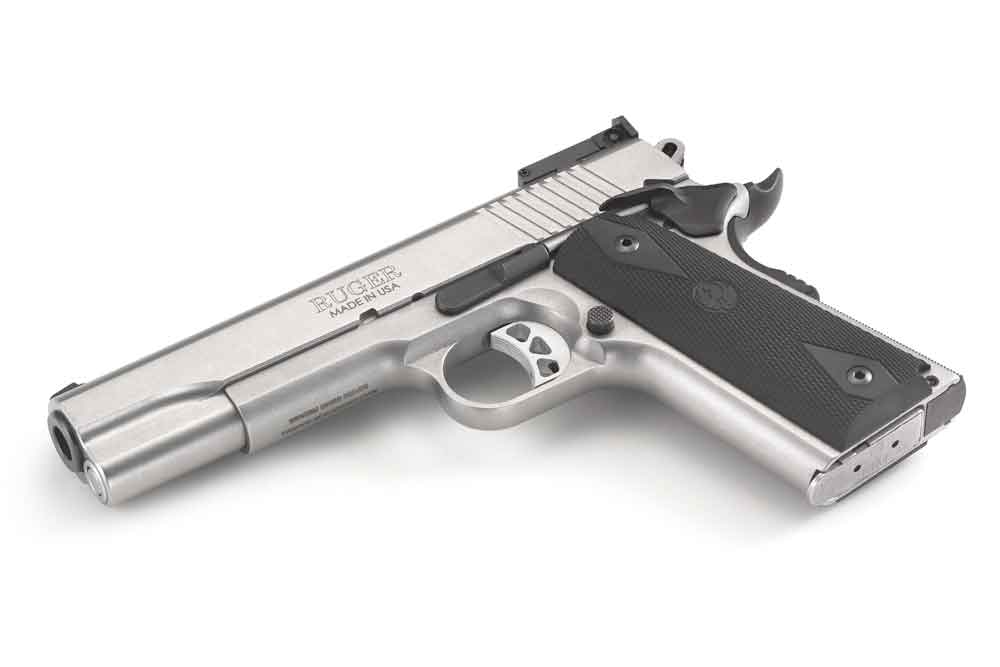
Economical and excellent up close, the .45 ACP is an exceptional choice for a self-defense, plinking and competition. The cartridge hits hard close range, makes big holes and has a proven track record saving lives. A more lenient recoil, it is also easier to become competent within a shorter amount of time and potentially is a faster option if follow-up shots are a concern. Less recoil also makes it a more logical choice if you’re looking for a compact carry gun.
Given its long lifespan, there are simply more pistol options to choose from for the .45 ACP. In turn, you have a greater likelihood of finding exactly the right pistol for your purposes, whatever they might be. And in the long run, it will prove cheaper to shoot. Ammo, at least at time of writing, is abundant and easy on the pocketbook. There are a lot of options, including self-defense, that falls below the 50-cents per round mark.
Conversely, if you have a yen for a handgun that reaches out, hits hard and — if you happen to reload — has more room to work with, your money might be better spent on a 10mm. Definitely, it’s the choice if you’re aiming at handgun hunting or need protection against four-legged predators, instead of simply two. Not that the “Perfect Ten” isn’t a capable self-defense cartridge — it is. Only it requires more time and effort to become truly proficient with, outside its lightest loads. This is especially the case if you opt for a smaller-framed model.
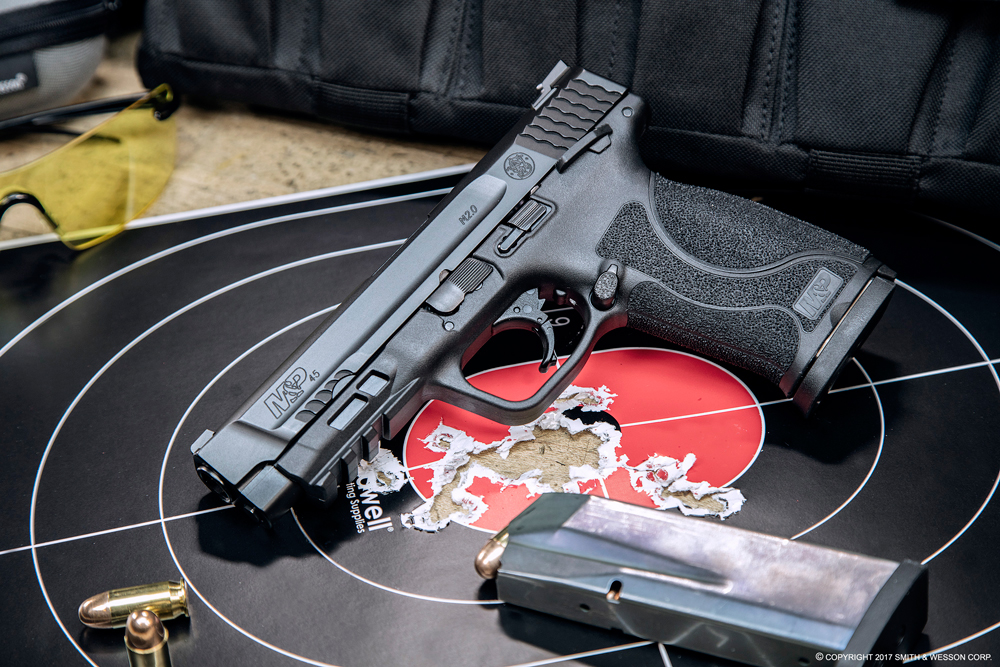
Given the cartridge is in its renaissance, you’re also limited in your pistol choices. Certainly, there are more options every year, but they are a fraction of what’s available for the .45. You don’t get to be as choosy. Things are brighter on the ammo horizon, there are more choices, and, as mentioned before, it perhaps has more handloading potential. Overall, a 10mm is tougher on the pocketbook. There are options less than 50-cents per round, but mostly range fodder. The self-defense stuff quickly gets up to $1 and above each trigger pull.
In either case — and like with all guns and cartridges — you should practice due diligence. Not only consider what you plan to use your 10mm or .45 ACP for, but also test drive the makes and models that get your trigger finger itching. Only after you drop the hammer will you know if you have found the right gun and cartridge. Do enough legwork and whether you settle on 10mm or .45 ACP, you will find either rock solid if they match up with your needs.
10mm & .45 ACP FAQ
Yes. 10mm Auto has a higher muzzle velocity and more energy than .45 ACP, it also retains more of that velocity and energy over greater distances. That said, “more powerful” is pretty vague when it comes to comparing handgun cartridges, and .45 ACP's larger diameter and typically heavier projectiles lends itself to potentially better expansion with hollow-points.
Yes, all else being equal 10mm Auto is louder than .45 ACP primarily due to its higher muzzle velocity. Standard 10mm ammo is always supersonic, which results in more noise as it breaks the sound barrier. Standard .45 ACP on the other hand is naturally subsonic, making for a quieter shooting experience and a more ideal round for use with a suppressor.
Yes, but only with proper shot placement. 10mm is on record as having killed grizzly bears before, but you still have to do your part to hit the right spots.
While the FBI did adopt 10mm Auto and then subsequently decommission it, it's only partly true to say that they “got rid of it.” The cartridge's hefty recoil combined with the large grips of the Smith & Wesson 1076 pistol were too much to handle for most average FBI agents, leading them to adopt .40 S&W instead. However, FBI HRT and SWAT teams did continue to use it, at least for a period.
10mm handguns are relatively versatile in their usefulness due to the several different styles and sizes that are now available. Boasting significantly more power than 9mm, 10mm is capable of putting down grizzly bears, bandits and everything in between. That power also makes 10mm handguns viable for hunting game like whitetail deer and boar. As long as you can handle the stronger recoil, a 10mm handgun would be a good choice for certain kinds of hunting, bear defense, some forms of competition shooting and even for protection against human attackers as a home defense or concealed carry gun.

Next Step: Get your FREE Printable Target Pack
Enhance your shooting precision with our 62 MOA Targets, perfect for rifles and handguns. Crafted in collaboration with Storm Tactical for accuracy and versatility.
Subscribe to the Gun Digest email newsletter and get your downloadable target pack sent straight to your inbox. Stay updated with the latest firearms info in the industry.

![Best Concealed Carry Guns In 2025 [Field Tested] Wilson Combat EDC X9S 1](https://gundigest.com/wp-content/uploads/Wilson-Combat-EDC-X9S-1-324x160.jpg)


![Best 9mm Carbine: Affordable PCCs [Tested] Ruger Carbine Shooting](https://gundigest.com/wp-content/uploads/Ruger-Carbine-Shooting-100x70.jpg)
![Best AR-15: Top Options Available Today [Field Tested] Harrington and Richardson PSA XM177E2 feature](https://gundigest.com/wp-content/uploads/Harrington-and-Richardson-PSA-XM177E2-feature-100x70.jpg)

I did better than buy one of each, I bought two of each. A mini model 1911 by Para Ordnance in 45ACP, 10 round magazine, and a regular 1911 ACP that I can put high capacity magazines into, including a drum magazine. I have the Colt Delta Elite in 10mm but it’s only a 7 or 8 round magazine, so I bought a Rock Island model 1911 in 10mm that holds a 16 round magazine. When the Walking Dead Zombie Invasion is upon us, I’m ready to rock & roll. That, or a gang home invasion, squatters or porch pirates.
Excellent article
I have Colt Delta Elite. I have never fired a “factory load.” By hand loading using cast bullets, lower velocity loads are pleasant to shoot. If I plan a bear hunt, I’ll purchase some factory loads and learn how to shoot them before I go!
I think the 10mm is a great choice, especially if you handload.
The resurgence of 10mm is because of memes and video games.
I had a K&N 10mm I sold in a pinch to get a capacitor upgrade on my bass amp, I regret selling it to this day.
You’ve thoughtfully integrated information, resulting in a reading experience that is informative.
There actually is a 40 super that exceeds 10mm power. That said, a 45 Super is about perfect for self defense.
“If your answer isn’t ‘Give me one of each!’ then you need a long hard chew on what you plan to do with your new 10mm or .45 ACP before getting one.”
And if your answer IS ”Give me one of each!” then maybe you still ought to think about what you would do with your new 10mm AND .45 ACP before getting one.
Most if not all warranties on a gun are not valid if you use hand loads . And in most self defensive uses over penetration of the target is an issue . Because if you ham a bystander most DA’s will do what ever they can to put your head on the chopping block . I have fired a 10mm and find the extra range and hitting power could be very helpful for some situations . But a slower .45 JHP for self defense is more practical for my needs .
should say harm not ham .lol
I, respectfully, would like to share an alternate historical view? I am an American, and will always consider myself so. I also have a home in the Philippines, and my wife, soulmate, best friend is a filipina. The article referred to the “Moro uprising?) In the Philippines, it is referred to as the Philippine American war. There are other issues that We, as Americans, tend to slant our philipine history, but that is for another day, another way. For now, may I share with you, an alternate version of the development, and adoption of the 1911 45? The US Cavalry felt that it’s side arm (38?) was an inadequate cavalry weapon? They wanted a more lethal sidearm? They put forth the request for a weapon, capable of stopping a horse? Wala – .45 1911. Oops, in visaya ( one of many philippine languages)wala means not or nothing. Are you open to my suggestion, that there or more than one view?
Regardless, the 45 ACP is more effective than the 38 Colt.
Hi Chip,
Well done, thanks for your input. I think it’s important to get our history straight as we Americans oftentimes like to place preferences over straight facts. It was definitely a war vs a mere ‘uprising’ as our American presence has/had a devastating effect upon its people.